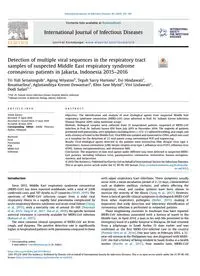
2019 Detection of multiple viral sequences in the respiratory tract samples of suspected Middle East respiratory syndrom PDF
Preview 2019 Detection of multiple viral sequences in the respiratory tract samples of suspected Middle East respiratory syndrom
Detection of multiple viral sequences in the respiratory tract samples of suspected Middle East respiratory syndrome coronavirus patients in Jakarta, Indonesia 2015–2016 Tri Yuli Setianingsiha, Ageng Wiyatnob, Teguh Sarry Hartonoa, Evi Hindawatia, Rosamarlinaa, Aghnianditya Kresno Dewantarib, Khin Saw Myintb, Vivi Lisdawatia, Dodi Safarib,* a Prof. Dr. Sulianti Saroso Infectious Disease Hospital, Jakarta, Indonesia b Eijkman Institute of Molecular Biology, Jakarta, Indonesia A R T I C L E I N F O Article history: Received 17 April 2019 Received in revised form 17 June 2019 Accepted 18 June 2019 Corresponding Editor: Eskild Petersen, Aarhus, Denmark Keywords: Viral Pneumonia PCR MERS-CoV Indonesia A B S T R A C T Objectives: The identification and analysis of viral etiological agents from suspected Middle East respiratory syndrome coronavirus (MERS-CoV) cases admitted to Prof. Dr. Sulianti Saroso Infectious Disease Hospital (IDH) using molecular assays. Methods: Biological samples were collected from 13 hospitalized patients suspected of MERS-CoV infection in Prof. Dr. Sulianti Saroso IDH from July 2015 to December 2016. The majority of patients presented with pneumonia, with symptoms including fever (�37.5 �C), labored breathing, and cough, and with a history of travel to the Middle East. Viral RNA was isolated and converted to cDNA, which was used as a template for the detection of 12 viral panels using conventional PCR and sequencing. Results: Viral etiological agents detected in the patients were enterovirus D68, dengue virus type 3, rhinovirus C, human coronavirus 229E, herpes simplex virus type 1, influenza virus H1N1, influenza virus H3N2, human metapneumovirus, and rhinovirus A60. Conclusions: The sequences of nine viral agents under different taxa were detected in suspected MERS- CoV patients, including influenza virus, paramyxovirus, coronavirus, enterovirus, human metapneu- movirus, and herpesvirus. © 2019 The Author(s). Published by Elsevier Ltd on behalf of International Society for Infectious Diseases. This is an open access article under the CC BY-NC-ND license (http://creativecommons.org/licenses/by- nc-nd/4.0/). Introduction Since 2012, Middle East respiratory syndrome coronavirus (MERS-CoV) has been reported worldwide, with a total of 2206 confirmed cases and 787 deaths in 27 countries (WHO, 2019). The spectrum of MERS-CoV infection ranges from a mild viral respiratory illness to a rapidly fatal pneumonia complicated by acute respiratory distress syndrome and acute renal failure (Chong et al., 2015), with a mortality rate of around 35–50% (Noorwali et al., 2015; Yang et al., 2017; Hui et al., 2018). No specific licensed antiviral treatment is currently available for MERS-CoV infection (Rabaan et al., 2017). The most common clinical symptoms of MERS-CoV are fever, cough, and dyspnea. The positive detection rate is significantly higher in hospitalized patients with pneumonia compared to those with upper respiratory tract infections. These symptoms usually occur with a mean incubation period of 2–13 days. Comorbidities such as diabetes mellitus, cirrhosis, and others affecting the respiratory, renal, and cardiac systems have been shown to increase the severity of the illness (Yang et al., 2017). However, there is lack of specific clinical symptoms to distinguish MERS-CoV from other respiratory pathogens (Butler, 2015), making it imperative that early detection and laboratory identification of coronavirus infection is performed in suspected patients. Three neighboring countries in Southeast Asia have reported MERS-CoV infections associated with a history of travel to the Middle East. In April 2014, a man in his mid-50s presented to the emergency ward of a public hospital in Malaysia. He had returned from a pilgrimage to Saudi Arabia 13 days earlier and was confirmed as the first MERS-CoV-infected case in the country (Premila Devi et al., 2014). One year later, in February 2015, a 31- year-old woman in the Philippines was also diagnosed with MERS- CoV; she had a history of being resident in Saudi Arabia as a health worker (Racelis et al., 2015). Four months later, MERS-CoV * Corresponding author. E-mail address:
